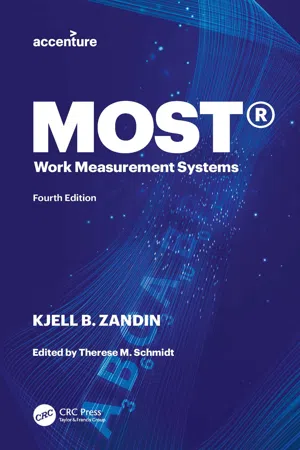
- 330 pages
- English
- ePUB (mobile friendly)
- Available on iOS & Android
MOST® Work Measurement Systems
About this book
This book is an essential supplement for MOST (Maynard Operation Sequence Technique) certification training. An excellent resource for practicing professionals and newcomers in the fields of industrial engineering and management, it provides a detailed explanation of each of the three MOST Systems. This edition is updated with relevant examples using today's technology to develop engineered standards. Content includes refreshed charts and guidelines to selecting a MOST System and completing a MOST analysis based on the application rules for BasicMOST, MiniMOST and MaxiMOST. A new informative chapter highlights the use of standards to improve workforce performance and increase productivity. A must for MOST certification for engineers, productivity improvement specialists, staffing, and costing professionals. Certification training can be completed online and worldwide through authorized partners.
Frequently asked questions
- Essential is ideal for learners and professionals who enjoy exploring a wide range of subjects. Access the Essential Library with 800,000+ trusted titles and best-sellers across business, personal growth, and the humanities. Includes unlimited reading time and Standard Read Aloud voice.
- Complete: Perfect for advanced learners and researchers needing full, unrestricted access. Unlock 1.4M+ books across hundreds of subjects, including academic and specialized titles. The Complete Plan also includes advanced features like Premium Read Aloud and Research Assistant.
Please note we cannot support devices running on iOS 13 and Android 7 or earlier. Learn more about using the app.
Information
1 The Concept of MOST—An Introduction
Work Measurement
- Plan for staffing associates.
- Determine labor costs based on activity-based standards.
- Identify the type and capacity of any needed equipment.
- Plan for the supply and delivery times of materials.
- Obtain predicted costs of production or service.
- Determine the overall production or service schedule.
- Analyze the feasibility of new products and services.
- Set expectations and follow-up on production or service goals.
- Manage individual or departmental performance.
- Implement a performance-based pay system.
- The conditions and actions under which the process was originally performed are consistently repeated.
- The actions to be performed will be performed exactly as those on which the historical data is based.
- The individual analyst must subjectively rate or compare the operator to an estimated 100% (average) performance standard.
- No matter how sophisticated, expensive or precise the timepiece, a watch simply does not forecast, predict or accurately determine times for future situations; it can only determine the time for what has already occurred based on existing work conditions (methods, layouts, capacities, etc.).
Table of contents
- Cover
- Half Title
- Title Page
- Copyright Page
- Dedication
- Table of Contents
- Foreword
- In Memory of Kjell B. Zandin
- Acknowledgments
- Author
- Editor
- Chapter 1 The Concept of MOST—An Introduction
- Chapter 2 The MOST Systems Family
- Chapter 3 The BasicMOST System
- Chapter 4 The MiniMOST System
- Chapter 5 The MaxiMOST System
- Chapter 6 Using MOST Standards to Manage Performance
- Appendix A: Theory
- Index
- Subject Categories
- Subject Index